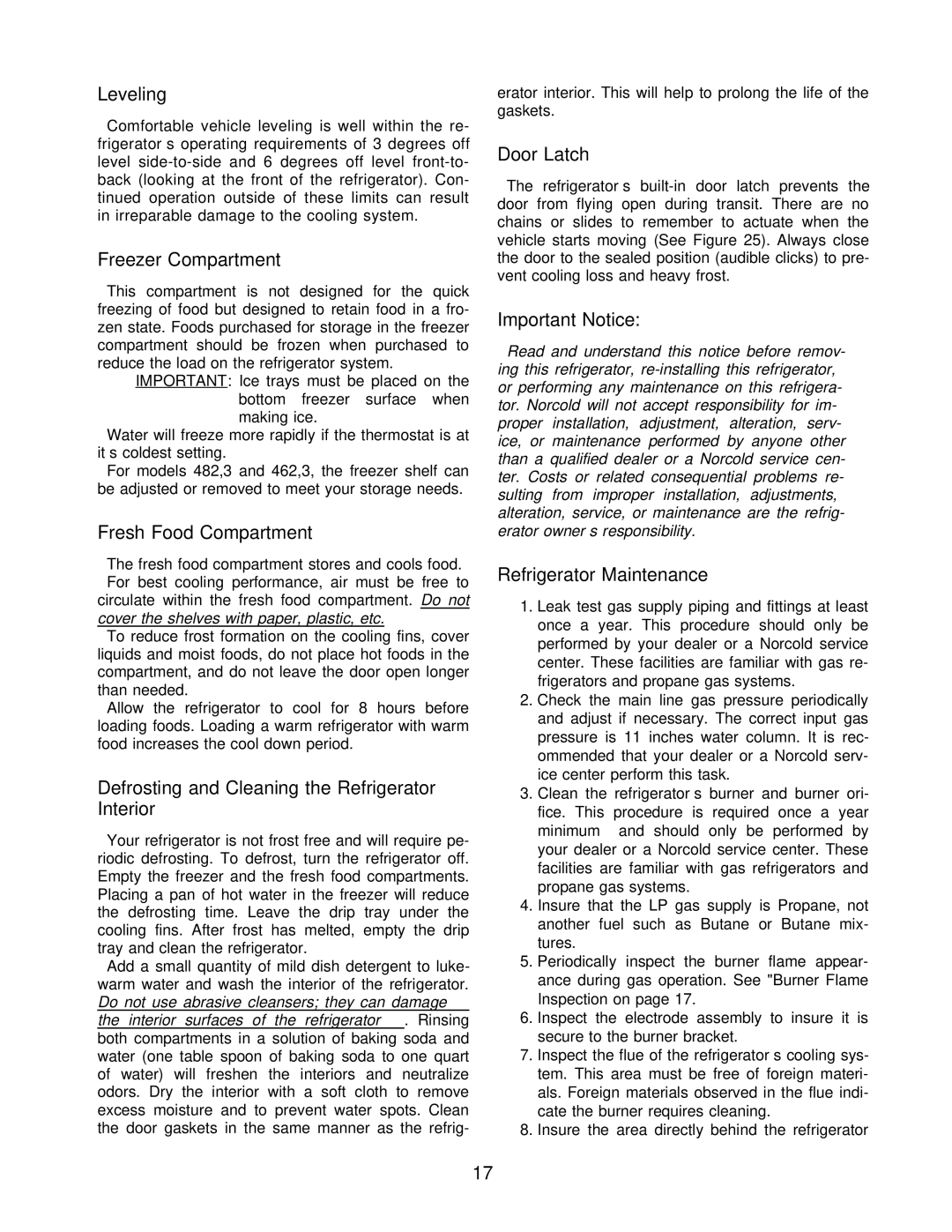Leveling
Comfortable vehicle leveling is well within the re- frigerator’s operating requirements of 3 degrees off level
Freezer Compartment
This compartment is not designed for the quick freezing of food but designed to retain food in a fro- zen state. Foods purchased for storage in the freezer compartment should be frozen when purchased to reduce the load on the refrigerator system.
IMPORTANT: Ice trays must be placed on the bottom freezer surface when making ice.
Water will freeze more rapidly if the thermostat is at it’s coldest setting.
For models 482,3 and 462,3, the freezer shelf can be adjusted or removed to meet your storage needs.
Fresh Food Compartment
The fresh food compartment stores and cools food. For best cooling performance, air must be free to circulate within the fresh food compartment. Do not
cover the shelves with paper, plastic, etc.
To reduce frost formation on the cooling fins, cover liquids and moist foods, do not place hot foods in the compartment, and do not leave the door open longer than needed.
Allow the refrigerator to cool for 8 hours before loading foods. Loading a warm refrigerator with warm food increases the cool down period.
Defrosting and Cleaning the Refrigerator Interior
Your refrigerator is not frost free and will require pe- riodic defrosting. To defrost, turn the refrigerator off. Empty the freezer and the fresh food compartments. Placing a pan of hot water in the freezer will reduce the defrosting time. Leave the drip tray under the cooling fins. After frost has melted, empty the drip tray and clean the refrigerator.
Add a small quantity of mild dish detergent to luke- warm water and wash the interior of the refrigerator.
Do not use abrasive cleansers; they can damage the interior surfaces of the refrigerator. Rinsing both compartments in a solution of baking soda and water (one table spoon of baking soda to one quart of water) will freshen the interiors and neutralize odors. Dry the interior with a soft cloth to remove excess moisture and to prevent water spots. Clean the door gaskets in the same manner as the refrig-
erator interior. This will help to prolong the life of the gaskets.
Door Latch
The refrigerator’s
Important Notice:
Read and understand this notice before remov- ing this refrigerator,
Refrigerator Maintenance
1.Leak test gas supply piping and fittings at least once a year. This procedure should only be performed by your dealer or a Norcold service center. These facilities are familiar with gas re- frigerators and propane gas systems.
2.Check the main line gas pressure periodically and adjust if necessary. The correct input gas pressure is 11 inches water column. It is rec- ommended that your dealer or a Norcold serv- ice center perform this task.
3.Clean the refrigerator’s burner and burner ori- fice. This procedure is required once a year minimum and should only be performed by your dealer or a Norcold service center. These facilities are familiar with gas refrigerators and propane gas systems.
4.Insure that the LP gas supply is Propane, not another fuel such as Butane or Butane mix- tures.
5.Periodically inspect the burner flame appear- ance during gas operation. See "Burner Flame Inspection on page 17.
6.Inspect the electrode assembly to insure it is secure to the burner bracket.
7.Inspect the flue of the refrigerator’s cooling sys- tem. This area must be free of foreign materi- als. Foreign materials observed in the flue indi- cate the burner requires cleaning.
8.Insure the area directly behind the refrigerator
17
